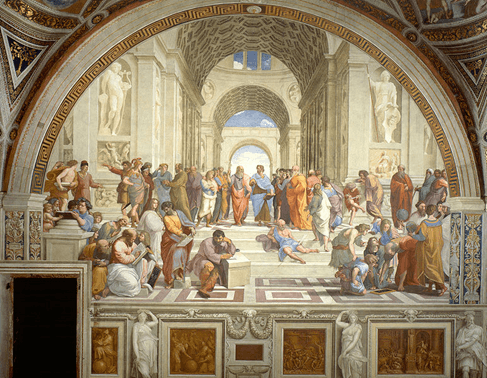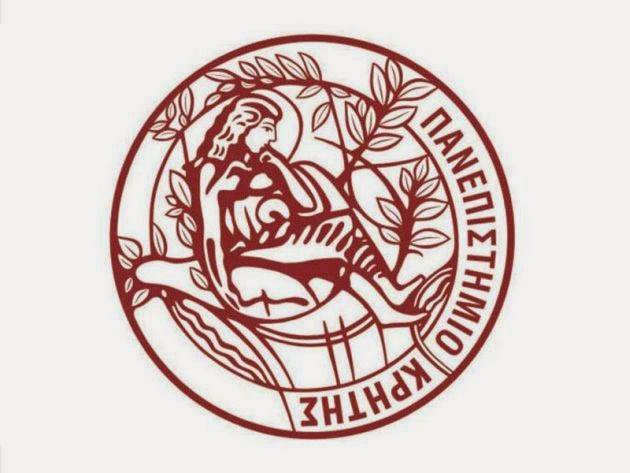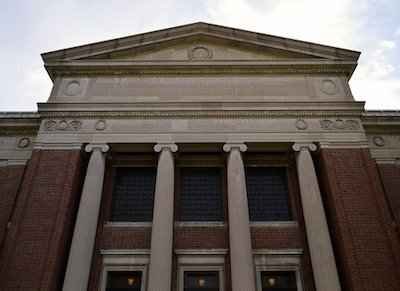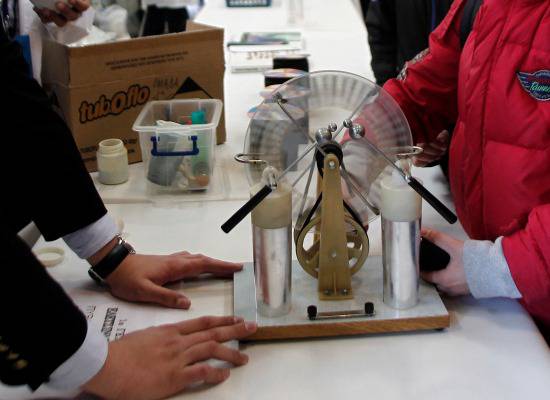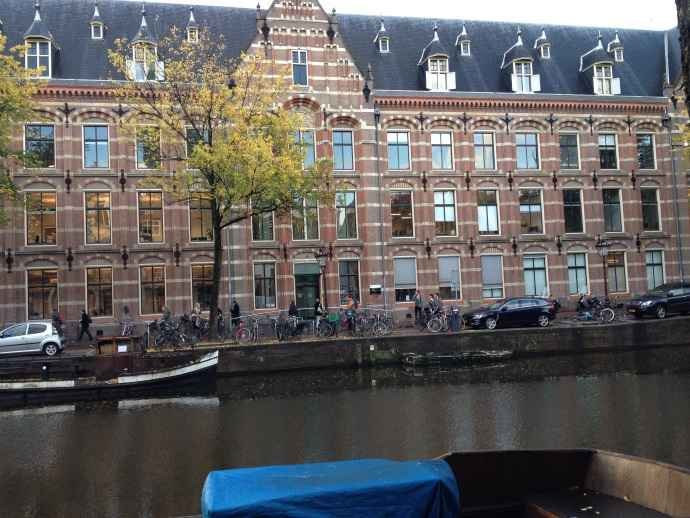Του Νίκου Τσούλια
Ο Homo Universalis συνδέθηκε με τις φωτεινές περιόδους της ανθρωπότητας. Ήταν το πορτρέτο του μορφωμένου ανθρώπου που αναδείχτηκε σε εποχές διαφωτισμού, σε εποχές ακτινοβολίας των γραμμάτων και των τεχνών. Εξέφραζε τον ολοκληρωμένο πνευματικά άνθρωπο που είχε συγκροτημένη άποψη για τα ζητήματα της επιστήμης αλλά και γενικότερα για τα ζητήματα του πολιτισμού. Είναι ο παγκόσμιος, ο καθολικόςάνθρωπος. Είναι ο άνθρωπος με το ανήσυχο πνεύμα και την κριτική σκέψη που μπορεί να έχει ουσιαστική άποψη για το κοινωνικό γίγνεσθαι, αφού κατέχει πολλαπλά ερμηνευτικά εργαλεία, αφού η ερευνητική ματιά είναι συστατικό στοιχείο της ύπαρξής του.
Γεννήθηκε την εποχή της Αναγέννησης, αλλά η εικόνα του επεκτάθηκε προς το παρελθόν για να συμπεριλάβει όλες τις μεγάλες μορφές της ανθρωπότητας, μορφές που επηρέασαν, στον έναν ή στον άλλο βαθμό, τη ροή της ιστορίας. Αναδύθηκε από την υπεροχή της μορφωτικής κουλτούρας που άνοιγε φωτεινούς ορίζοντες στο μέλλον των κοινωνιών, συνδέθηκε με την πολυμάθεια και με την ευρύτητα της γνώσης που μπορούν να δώσουν περιεχόμενο και νόημα στην ίδια τη ζωή. Κορυφές του είναι ο Αριστοτέλης του αρχαιοελληνικού διαφωτισμού και ο Λεονάρντο ντα Βίντσι της Αναγέννησης. Και οι δύο αποτελούν τις αρχετυπικές μορφές του πνευματικά ολοκληρωμένου ανθρώπου.
Ωστόσο, όσο προχωρούσε η περίοδος της νεωτερικότητας η ιδέα του Homo Universalis άρχισε να εγκαταλείπεται. Ο καταμερισμός εργασίας, το φορντικό μοντέλο παραγωγής, η μεγάλη συσσώρευση γνώσεων και πληροφοριών και η διαρκής εξειδίκευση στο χώρο της επιστήμης και της τέχνης «επέδραμαν» κατά του σχήματος του καθολικού ανθρώπου. Ποιος θα μπορούσε στη διάρκεια της ζωής του να αποκτήσει μια στοιχειώδη επάρκεια των βασικών στοιχείων όλων των περιοχών του επιστητού; Ποιος θα μπορούσε να κατακτήσει το βασικό πυρήνα της πολυμάθειας, για να μπορεί να ανταποκρίνεται στα πολλαπλά ερωτήματα που τίθενται στον πολίτη; Η γνώση εγκιβωτίστηκε σε στεγανά· αργότερα θα προκύψουν η διεπιστημονικότητα και η διαθεματικότητα για να βρουν δρόμους ουσιαστικής επικοινωνίας οι επιστήμονες των διαφόρων γνωστικών περιοχών. Η επιστήμη ήταν απόλυτη: διαφοροποίηση των επιμέρους όψεων της γνώσης, διαρκής εξειδίκευση, επαγγελματοποίηση με παράλληλο επιμερισμό για όσους θα αναλάμβαναν περαιτέρω την ευθύνη της λειτουργίας των οργανωμένων θεσμών της εκπαίδευσης και της έρευνας. Η κοινωνία οργανωνόταν με πρότυπα στεγανοποίησης των διάφορων οικονομικών και κοινωνικών χώρων. Η έννοια των επαγγελματικών προσόντων και των επαγγελματικών δικαιωμάτων έγινε ουσιαστικά η χάρτα διαμόρφωσης των σύγχρονων κοινωνιών.
Η βιομηχανική επανάσταση ήταν απόλυτη: καταμερισμός εργασίας παντού. Ο άνθρωπος γίνεται μέρος μιας αλυσίδας λειτουργιών, που όχι μόνο δεν την καθορίζει πλέον, αλλά και δεν έχει ούτε γενική γνώση ούτε κριτική άποψη επ’ αυτής. Ο άνθρωπος αποξενώνεται από την εργασία του, από το προϊόν του, από το δημιούργημά του, γίνεται μονοδιάστατος. Ο άνθρωπος γίνεται μέρος της μηχανής. Αντί να εξανθρωπιστεί η μηχανή, μηχανοποιείται ο άνθρωπος. Η πρόοδος έχει «τίτλο»: η κοινωνία της αφθονίας έχει ως βάση τη μαζική παραγωγή και την καταναλωτική κουλτούρα. Ο άνθρωπος αλλοτριώνεται με το δέλεαρ της διαρκούς οικονομικής μεγέθυνσης, η οποία καταλαμβάνει το περιεχόμενο και της έννοιας της συνεχούς προόδου. Η ιστορία όμως διαψεύδει τον μύθο αυτής της ταύτισης οικονομικής συσσώρευσης και προόδου και θέτει προς συζήτηση το θέμα: τι είναι πρόοδος και τι ευημερία;
Ωστόσο, η αρτιωμένη πνευματική καλλιέργεια είναι συστατικό στοιχείο της ανθρώπινης ύπαρξης, είναι ψυχική ανάγκη. Τίθεται ένα απλό ερώτημα για τη ζωή του ανθρώπου και για την αναζήτηση του περιεχομένου της: εφόσον όλες οι υπαρξιακές και θεμελιώδεις απορίες και όλοι οι ουσιαστικοί στοχασμοί ως προς τον κόσμο, την πραγματικότητα, τον εαυτό μας είναι στοιχεία καθολικά και παγκόσμια σε όλους τους ανθρώπους, όπου γης και όπου χρόνου, πώς μπορεί να κατακτηθεί οποιοδήποτε νόημα ζωής με τεμαχισμό των σκέψεων και των συλλογισμών που, ούτως ή άλλως, δεν μπορούν να επιμεριστούν; Πώς μπορεί να εξαχθεί η όλη εικόνα της γνώσης και της σχέσης μας με τη γνώση, όταν με το άθροισμα των μερών δεν προκύπτει το σύνολο. Το προκύπτον ζήτημα δεν είναι μεθοδολογικό. Είναι βαθιά πολιτικό και πολιτισμικό. Συναρτάται με το τι άνθρωπο και τι κοινωνία θέλουμε να δημιουργήσουμε, συναρτάται με το πώς θέλουμε να ορίσουμε την αυτογνωσία και την ετερογνωσία.
Η στροφή που προτείνει η UNESCO για επαναπροσδιορισμό και ενίσχυση της γενικής παιδείαςστηρίζεται ακριβώς σε αυτή την ιδέα: στην καλλιέργεια του ολοκληρωμένου πνευματικά ανθρώπου. Τα πιο ονομαστά πανεπιστήμια του κόσμου επιζητούν στους υποψηφίους τους πρωτίστως την πολλαπλά καλλιεργημένη προσωπικότητα, επιζητούν την ευρύνοια και την ευρυμάθεια. Φυσικά και δεν μπορούμε να γευθούμε όλες τις γνώσεις του επιστητού ούτε είναι αυτό το αιτούμενο. Στόχος είναι η διαρκής μορφωτική προσπάθεια του ανθρώπου για την κατάκτηση των βασικών στοιχείων όλων των περιοχών της, ούτως ή άλλως, ενιαίας γνώσης, για να μπορεί ο άνθρωπος να έχει άποψη για τη ζωή, για τον κόσμο και τον εαυτό του. Αλλά ακόμα και αν η κατάκτηση αυτού του πορτρέτου του Homo Universalis, του πολυΐστορος και ευρυμαθούς πολίτη, δεν είναι πλήρης, δεν είναι το ταξίδι προς αυτό το σκοπό μια πλήρωση της ανθρώπινης αγωνίας και αναζήτησης; Γιατί οι κομματιασμένες γνώσεις όχι μόνο δεν οδηγούν στην κριτική σκέψη και στο υπαρξιακό σκέπτεσθαι, αλλά και μάς απομακρύνουν από την προσπάθεια κατάκτησης του ορθού λόγου. Γιατί το θεμελιακό ζήτημα δεν είναι η γνώση των πραγμάτων αλλά η γνώση του νοήματος αυτών. Και η γνώση αυτή μόνο καθολική μπορεί να είναι.
Στη συνέχεια παρατίθεται ένας σχετικός πίνακας από τη Wikipedia, που, αν και δεν μπορεί να είναι απόλυτης αξίας, έχει τη σπουδαιότητά του και τη σημασία του.
![]()
The following is a list of people who have been described as a polymath by reliable sources.
The list below is organized by date of birth year.
-
Imhotep (fl. 2650–2611 BC);[1][2] Egyptian chancellor, physician, and architect; “Imhotep, circa 2650 BC (who was revered as being at least semi-divine until the Late Period, although some of this reverence may be due to his status as physician and all-round polymath).”[3]
-
Pythagoras (c. 580–490 BC), a Greek mathematician and philosopher of 6th century BC who founded a school in Crotone in south Italy and a philosophical system, Pythagoreanism, named after him. Pythagoras was thought to be a polymath by his contemporaries.[4] He is sometimes credited with coining the term “philosopher”, literally a “lover of wisdom,” and considered among the first to follow this vocation.[5]
-
Archytas (428–347 BC); an Ancient Greek philosopher, mathematician, astronomer, statesman, and strategist; famous for being the reputed founder of mathematical mechanics.
-
Aristotle (384–322 BC); a Greek philosopher, a student of Plato and teacher of Alexander the Great. He wrote on many subjects, including physics, metaphysics, poetry, theater, music, logic, rhetoric, politics, government, ethics, biology and zoology. He numbers among the greatest polymaths of all time.[6][7] “Aristotle was an extraordinary polymath…”[8]
-
Archimedes (c.287–c.212 BC); a Greek mathematician, physicist, engineer, inventor, and astronomer. Lived in Sicilian Greek town of Syracuse. Often considered one of the greatest mathematicians of all time,[9][10] Archimedes is noted for several advancements in almost every relevant field in his era.
-
Zhang Heng (78-139); a Han Dynasty Chinese official, scholar of history and philosophy,poet, mathematician, astronomer, inventor, geographer, cartographer, painter, and sculptorwho invented the world’s first water-powered armillary sphere and the world’s firstseismometer to detect the cardinal direction of distant earthquakes; he is often described as a polymath.[11][12][13][14]
-
Zhuge Liang (181–234)[15] was a strategist, inventor, engineer, scholar, astrologer, statesman and chancellor of Shu Han during the Three Kingdoms period of Chinese history. He is often recognised as the greatest and most accomplished strategist of his era.[16] His name – even his surname alone – has become synonymous with intelligence and strategy in Chinese culture.
-
Acharya Nāgārjuna (ca. 150–250) was an Indian philosopher who founded theMadhyamaka school of Mahāyāna Buddhism [17]. He was not only a philosopher monk but also a physician who practised in the Susratha school, a chemist and a writer as well. His writings are the basis for the formation of the Madhyamaka school, which was transmitted to China under the name of the Three Treatise (Sanlun) School. He is credited with developing the philosophy of the Prajnaparamita sutras, and was closely associated with the Buddhist university of Nalanda. In the Jodo Shinshu branch of Buddhism, he is considered the FirstPatriarch. Little is known about the actual life of the historical Nagarjuna. The two most extensive biographies of Nagarjuna, one in Chinese and the other in Tibetan, were written many centuries after his life and incorporate material seen by some as historically unreliable. Nagarjuna was born a Brahmin,[18] which in his time connoted religious allegiance to the Vedas, probably into an upper-caste Brahmin family and probably in the southern Andhraregion of India.[19]
-
Hypatia (<370-415) was a scholar and teacher in Roman Alexandria. She is considered the first notable female mathematician and also taught philosophy and astronomy.
-
Aryabhata (IAST: Āryabhaṭa; Sanskrit: आर्यभटः) (476–550) was the first in the line of greatmathematician–astronomers from the classical age of Indian mathematics and Indian astronomy. His most famous works are the Aryabhatiya (499, when he was 23 years old) and the Arya-siddhanta. He is credited for the place-value system, the approximation of pi value, discovering that the earth rotates on it’s axis and the cause for eclipse occurrences.
-
Ja’far al-Sadiq (702-765); He was a polymath: an astronomer, alchemist, Imam, Islamic scholar, Islamic theologian, writer, philosopher, physician, physicist and scientist. He was also the teacher of the famous chemist, Jābir ibn Hayyān (Geber),[20][21] and a contemporary ofAbū Ḥanīfa, founder of the Hanafi school of Sunni jurisprudence.
-
Jābir ibn Hayyān (Geber) (721–815);[22][23] born in Tus in Persia a Persian (or Arab) Muslim chemist, alchemist, astrologer, astronomer, engineer, pharmacist, physician,philosopher, physicist and scientist; “Jabir was a polymath who wrote 300 books on philosophy, 1,300 books on mechanical devices and military machinery, and hundreds of books on alchemy.”[24]
-
Al-Khwarizmi (c. 780–850); “… a Persian mathematician, astronomer, and geographer, was the greatest polymath (a person of encyclopedic learning) in the House of Wisdom inBaghdad.”[25] “…the polymath researcher…”[26]
-
Al-Jahiz (781-869); was a famous Arab scholar and polymath.[27] He was an Arabic prosewriter and author of works on Arabic literature, biology, zoology, history, early Islamic philosophy, Islamic psychology, Mu’tazili theology, and politico-religious polemics.
-
Ziryab (789-857); an Iraqi–Andalusian poet, musician, singer, cosmetologist, fashion designer, celebrity, trendsetter, strategist, astronomer, botanist and geographer; “Zaryab was a “renaissance man” before the Renaissance.”[28][29]
-
Al-Kindi (Alkindus) (801–873);[30][31] an Arab astronomer, geographer, mathematician,meteorologist, musician, philosopher, physician, physicist, scientist, and politician.
-
Abbas Ibn Firnas (810-887); was a Berber polymath:[32][33] an inventor, engineer,aviator, physician, Arabic poet, and Andalusian musician.[33] He was born in Izn-Rand Onda,Al-Andalus (today’s Ronda, Spain), and lived in the Emirate of Córdoba. He is known for an early unsuccessful attempt at aviation.[34][35]
-
Abu Zayd al-Balkhi (850-934); was a Persian Muslim polymath: a geographer,mathematician, physician, psychologist and scientist. Born in Shamistiyan, in the Persian province of Balkh (now in Afghanistan), he was a disciple of al-Kindi. He was also the founder the “Balkhī school” of terrestrial mapping in Baghdad.[36]
-
Muhammad ibn Zakariya Razi (Rhazes) (865–925);[37] a Persian physician, alchemist, chemist, philosopher and scholar.[38] “Like other Muslim intellectuals of that period, Razi was a polymath. Only half of his nearly 200 written works deal with medicine, the rest are on other topics, such as astronomy, mathematics, philosophy and theology…”[39]
-
Al-Farabi (Alpharabius) (872-951); He “was a Muslim[40] polymath and one of the greatest scientists and philosophers of the Islamic world in his time. He was also acosmologist, logician, musician, psychologist and sociologist.”[41]
-
Abu al-Hasan ‘Ali al-Mas’udi (896-956);[31][42] an Arab historian, Earth scientist, Islamic scholar, geographer, geologist, and traveller.[43] An “erudite polymath…”[44] “Prolific writer and polymath. His known works number over twenty and deal with a wide variety of religious and secular subjects, including history (both Islamic and universal), geography, the natural sciences, philosophy, and theology…”[45]
-
Chavundraya (or Chamundaraya) (940–989) was a military commander, poet and a minister in the court of the Western Ganga Dynasty of Talakad (in present day Karnataka, India). A person of many talents, in 982 he commissioned the Gomateshwara, a monolithicsculpture in Shravanabelagola, an important place of pilgrimage for Jains. He was a devotee of the Jain Acharya Nemichandra and Ajitasena Bhattaraka and was an influential person during the reign of Kings Marasimha II, Rachamalla IV, and Rachamalla V (Rakkasa Ganga). A courageous commander with the title of Samara Parashurama, he found time to pursue his literary interests as well and became a renowned writer in Kannada and Sanskrit.[46][47] He wrote an important and existing prose piece called Chavundaraya Purana (also known asTrishasthi Lakshana Purana) in Kannada (978) and Charitrasara in Sanskrit. In his writing, he claims he was from the Brahmakshatriya Vamsa (Brahmin and converted to the Kshatriyacaste).[48] He patronised the famous Kannada grammarians Gunavarma and Nagavarma I and the poet Ranna whose writing Parusharama Charite may have been a eulogy of his patron.[46]Because of his many lasting contributions, Chavundaraya is an important figure in the history of medieval Karnataka.
-
Abhinavagupta (fl. 975–1025);[49] an Indian philosopher, literary critic, Shaivite,aesthetist, musician, poet, dramatist, dancer, exegetical theologian, and logician; “the great Kashmiri philosopher and polymath, Abhinavagupta”.[49]
-
Ibn al-Haytham (Alhazen) (965–1039), an Iraqi scientist, physicist, anatomist, physician, psychologist, astronomer, engineer inventor, mathematician, ophthalmologist, philosopher, and Ash’ari theologian; “a devout, brilliant polymath”;[50] “a great man and a universal genius, long neglected even by his own people”;[51] “Ibn al-Haytham provides us with the historical personage of a versatile universal genius.”[52] He is often credited with codifying the earliest form of the contemporary scientific method.[53]
-
Abū Rayhān al-Bīrūnī (973–1048), a Persian scientist, physicist, anthropologist,astronomer, astrologer, encyclopedist, geodesist, geographer, geologist, historian,mathematician, natural historian, pharmacist, physician, philosopher, scholar, teacher, Ash’aritheologian, and traveller; “al-Biruni was a polymath and traveler (to India) who introduced Indian scientific knowledge & thought to the Middle East & the West, making contributions in mathematics, geography and geology, natural history, calendars and astronomy”.[54]
-
Avicenna (980–1037); a Persian astronomer, chemist, geologist, logician, paleontologist,mathematician, physicist, poet, psychologist, scientist and teacher. He wrote almost 450 treatises on a wide range of subjects and in particular on medicine which was taught in medieval universities as late as 1650. He is also considered the father of the fundamental concept of momentum in physics,[55] and regarded as a pioneer of aromatherapy for his invention of steam distillation and extraction of essential oils.[56] He also developed the concept of uniformitarianism and law of superposition in geology,for which he is considered to be the ‘father of geology‘.
-
Ibn Hazm (994–1064) An Andalusian-Arab polymath[57][58] who produced “… some 400 works, covering jurisprudence, logic, history, ethics, comparative religion, and theology, andThe Ring of the Dove, on the art of love.”[59]
-
Shen Kuo (1031–1095);[60] a Chinese scientist, statesman, mathematician, astronomer,meteorologist, geologist, zoologist, botanist, pharmacologist, agronomist, ethnographer,encyclopedist, poet, general, diplomat, hydraulic engineer, inventor, academy chancellor,finance minister, and inspector; “Chinese polymath and astronomer who studied medicine, but became renowned for his engineering ability.”[60]
-
Omar Khayyám (1048–1131);[31][38][61] a Persian poet, writer, astronomer,mathematician, physician and philosopher.[62] He also wrote treatises on mechanics,geography, music and was a physicist.[63]
-
Al-Ghazali (1058–1111); He was a Persian jurist, philosopher, cosmologist, psychologist,mystic and Islamic theologian. He is considered a pioneer of the methods of doubt andskepticism and was an encyclopedic author, polymath, theorist, philosopher, moralist, critic and comparative religionist.[64][65]
-
Acharya Hemachandra (1089–1172); an Indian scholar, poet, linguist, grammarian,historian, philosopher, and prosodist; “the great polymath Hemacandra”;[66] “Hemacandra (1089–1172) was one of the great polymaths of medieval India.”[67]
-
Ibn Bajjah (Avempace) (1095–1138); Was an Andalusian-Arab Muslim polymath:[38] anastronomer, logician, musician, philosopher, physician, physicist, psychologist, poet andscientist.[68]
-
Hildegard of Bingen (1098–1179); also known as Saint Hildegard, and Sibyl of the Rhine, was a writer, composer, philosopher, Christian mystic, German Benedictine abbess, visionary, and polymath.[69]
-
Ibn Tufail (Abubacer) (1105–1185);[38] an Andalusian Arab “polymath scholar”,[70]Islamic philosopher, physician, Arabic writer, novelist, and court official.
-
Ibn Rushd (Averroes) (1126–1198); was an Andalusian Muslim polymath; a master ofIslamic philosophy, Islamic theology, Maliki law and jurisprudence, logic, psychology, politics,Arabic music theory, and the sciences of medicine, astronomy, geography, mathematics,physics and celestial mechanics. He has been described by some as “one of the spiritual fathers of Europe,”[71] although other scholars oppose such claims.[72][73]
-
Maimonides (1135–1204); rabbi, philospher, theologian, physician to Saladin, mathematician, astronomer, scientist.[74][75]
-
Al-Jazari (1136–1206); was a prominent Arab polymath: an Islamic scholar, inventor,mechanical engineer, craftsman, artist, mathematician and astronomer from Al-Jazira, Mesopotamia, who lived during the Islamic Golden Age (Middle Ages). He is best known for writing the Kitáb fí ma’rifat al-hiyal al-handasiyya (Book of Knowledge of Ingenious Mechanical Devices) in 1206, where he described fifty mechanical devices along with instructions on how to construct them.[76]
-
Fakhr al-Din al-Razi (1149–1209); “the polymath Fakhr al-Din Al-Razi”;[77] “one of the outstanding figures in Islamic theology… he also wrote on history, grammar, rhetoric, literature, law, the natural sciences and philosophy, and composed one of the major works of Qur’anic exegesis, the only remarkable gap in his output being politics.”[78]
-
Frederick II, Holy Roman Emperor (1194–1250); King of Germany, Italy, Burgundy and Sicily. Lived most of his life in Sicily. A polyglot speaking eight or nine languages with high literacy in seven. He was a respected warrior and wise negotiator, who cultivated arts and letters. Frederick was patron of a crucially important poetic tradition, the Sicilian School, cited by Dante Alighieri as critical stage in the literary development of Italian and Romance languages in general and vernaculars (i.e. non Latin languages) across Europe. For about a century the poetry of the Palermo court produced a stylistically advanced Sicilian which preceded the Tuscan advanced by Dante as preferred language of Italy and shaped Dante’s view that vernaculars should replace Latin. Frederick was also a multiculturalist, welcoming Greek, Latin, German, native Sicilian and French influences as well as the Arabic inheritance of Sicily. He founded the University of Naples and granted it academic freedom, a very enlightened act at a time when institutions of higher learning were rarely ‘free’ and autonomous. He was a religious skeptic, occasionally defying Popes. An acknowledged expert and writer on falconry with significant zoological studies. He was a lawyer and judge and theorised about the law and its role. He ruled over a brilliant court and cultivated the arts. Known in his time as “stupor mundi”, wonder of the world, a kind of 13th century substitute for “polymath”.[79][80]
-
Nasir al-Din al-Tusi (Tusi) (1201–1274);[81][82] a Persian polymath, prolific writer, anastronomer, biologist, chemist, mathematician, philosopher, physician, physicist, scientist,theologian and Marja Taqleed. He was one of the greatest scientists of the thirteenth century;[43] “the ensemble of Tusi’s writings amounts to approximately 165 titles on a wide variety of subjects (astronomy, ethics, history, jurisprudence, logic, mathematics, medicine, philosophy,theology, poetry and the popular sciences).”[83]
-
Albertus Magnus (Albert the Great) (1206–1280); was a Dominican Scholastic philosopher, theologian, and scientist who studied at the University of Paris. “He is called ‘the Great’, and ‘Doctor Universalis’ (Universal Doctor), in recognition of his extraordinary genius and extensive knowledge, for he was proficient in every branch of learning cultivated in his day, and surpassed all his contemporaries, except perhaps Roger Bacon (1214-94), in the knowledge of nature.”[84]
-
Ibn al-Nafis (1213–1288);[85] an Arab physician, anatomist, biologist, physiologist, surgeon, ophthalmologist, Ulema, Hafiz, Muhaddith, Shafi`i jurist and lawyer, Sunnitheologian, philosopher, litterateur, logician, novelist, psychologist, scientist, science fictionwriter, astronomer, cosmologist, futurist, geologist, grammarian, linguist, historian, philosopher of history, philosopher of religion, natural philosopher and sociologist; “Ibnul-Nafees was not only a great physician and discoverer of the minor blood circulation(pulmonary circulation), but he also had many interests, views and works about many other branches of knowledge.”[86][87]
-
Roger Bacon (1220–1292); A Franciscan friar and Master at Oxford who studied Aristotelian philosophy, optics, languages, alchemy, astronomy and mathematics.[88] He is also credited for providing an early recipe for gunpowder.
-
Qutb al-Din al-Shirazi (1236–1311); was a 13th century Persian Muslim polymath[89] and Persian poet who made contributions astronomy, mathematics, medicine, physics, music theory, philosophy and Sufism.[90]
-
Amir Khusrow (1253–1325), an Indian Muslim scholar, he was a poet, inventor, mystic, writer, musician, linguist, soldier and historian. Born to a Turkish-Afghan father and an Indian mother (the latter a native of Delhi) in Etah, North India he is best known for his poetry composed in Persian and Hindi (then called Hindustani) under the Delhi Sultans;[91] among his best known works were The Tale of the Four Dervishes and Khamsa-e-Nizami (or Khamsa-e-Khusrau) which includes the popular Indian classical romance Majnun-Laila.[92] He also spoke Arabic and Sanskrit. In 1285 Khusrow participated as a soldier in the war against the invading Mongols; he was taken prisoner, but he managed to escape. In 1301 when Ala ud din Khilji ,the Delhi Sultanate Emperor, attacked Ranthambhor, Chittor, Malwa and other places, Khusro accompanied the king in order to write chronicles. As a Sufi mystic he was a close aide of Nizamuddin Auliya,a famous Sufi Saint. In 1321 he wrote the Tughlaqnama, a history of theTughluq dynasty.Khusrow is also known to have invented the classical Hindustani instruments the Tabla and the sitar. He is known for introducing Qawwali, Khayal and Tarana types into Hindustani classical music.[93][94]
-
Ibn al-Banna (1256–1321); He wrote “100 titles, out of which some 50 are dedicated to mathematics and astronomy (including astrology), but the list also includes Quranic studies,theology (ūsul al‐dīn), logic, law (fiqh), rhetoric, prosody, Sufism, the division of inheritances (farāʾiḍ), weights and measures, measurement of surfaces (misāḥa), talismanic magic, andmedicine“,[95] and so he is considered by many as a polymath.[96]
-
Ibn al-Khatib (1313–1374); was a poet, writer, historian, philosopher, physician andpolitician from Al-Andalus.[97] Some of his poems decorate the walls ot the Alhambra inGranada. “Ibn al-Khatib was a polymath for his time and place. Distinguished inmany branches oflearning, he wrote on history, philosophy, mysticism, and medicine, as well as a considerable amount of poetry.”[98] He is also cited as a polymath by Britannica.[99]
-
Ibn Khaldun (1332–1406); “…was an Arab polymath[100][101] — an astronomer,economist, historian, Islamic jurist, Islamic lawyer, Islamic scholar, Islamic theologian, hafiz,mathematician, military strategist, nutritionist, philosopher, social scientist and statesman—born in North Africa in present-day Tunisia.[102] He is considered a forerunner of several social scientific disciplines: demography,[103] cultural history,[104][105] historiography,[106][107][108]the philosophy of history,[109] and sociology.[103][107][108][109][110][111] He is also considered one of the forerunners of modern economics,[107]“[112][113] and was also known for a “proto-theory” of evolution which predated Darwin and LaMarck[114] by several centuries.
-
Nicholas of Cusa (1401–1464); was a cardinal of the Catholic Church from Germany (Holy Roman Empire), a philosopher, theologian, jurist, mathematician, and an astronomer. He is widely considered one of the great geniuses and polymaths of the 15th century.
-
Leone Battista Alberti (1404–1472); “often considered the archetype of the Renaissance polymath”[115]
-
Suyuti (1445–1505);[116] an Egyptian Arab Islamic scholar, Sunni theologian, Shafi’i jurist,Arabic grammarian and linguist, historian, and Islamic philosopher.[38] “…the geat Egyptian polymath al-Suyuti…”[117] “…the great polymath-historian Jalal al-Din al-Suyuti…”[118] “…the noted Arab polymath al-Suyuti…”[119]
-
Leonardo da Vinci (1452–1519);[120][121] artist, scientist, inventor, painter, sculptor,architect, engineer, mathematician, physicist, philosopher, humanist, alchemist, biologist,naturalist, anatomist, geologist, technologist, astronomer, cartographer, botanist, cryptographer, geometer, draftsman, designer, scenographer, stylist, musician, writer, authorand poet. Often called geniuses’ genius and Universal Genius, is regarded as “the original ‘Renaissance Man‘” and is one of the most recognizable polymaths ever. He is widely considered to be one of the greatest painters of all time and perhaps the most diversely talented person ever to have lived.[122] “In Leonardo Da Vinci, of course, he had as his subject not just an ordinary Italian painter, but the prototype of the universal genius, the ‘Renaissance man’…”; “prodigious polymath…”.[123] “The scope and depth of his interests were without precedent… His mind and personality seem to us superhuman”.[124] A man of “unquenchable curiosity” and “feverishly inventive imagination”.[125] Among his works, theMona Lisa is the most famous and most parodied portrait and The Last Supper the most reproduced religious painting of all time. Leonardo’s drawing of the Vitruvian Man is also regarded as a cultural icon, being reproduced on everything from the euro to text books to t-shirts. Leonardo is revered for his technological ingenuity. He conceptualised a helicopter, atank, concentrated solar power, a calculator, the double hull and outlined a rudimentary theory of plate tectonics. He made important discoveries in anatomy, civil engineering, optics, and hydrodynamics. Leonardo’s scientific accomplishments are often reduced to inventions (of which he made very many) or to speculation, and an adventurous spirit. Recent writing shows that he was in fact a serious and brilliant scientist, concerned with what today is called ‘systems theory’, or complex systems; but he devised scientific reasoning models for experimentation, and conducted experiments with validation procedures, all of which qualify him as a scientist in the true sense as well.[126] For the extraordinary and unprecedented range of his work, of which only a minority survives, he is universally considered one of the greatest geniuses in the history of mankind.
-
Gerolamo Cardano (1501–1576), an Italian mathematician and inventor.
-
Taqi al-Din Muhammad ibn Ma’ruf (Takiyuddin) (1526–1585); Was a major “Muslim polymath: a scientist, astronomer and astrologer, engineer and inventor, clockmaker,physicist and mathematician, botanist and zoologist, pharmacist and physician, Islamic judgeand mosque timekeeper, Islamic philosopher and theologian, and madrasah teacher. He was the author of more than 90 books on a wide variety of subjects, including astronomy,astrology, clocks, engineering, mathematics, mechanics, optics and natural philosophy.[citation needed]
-
Matteo Ricci (1552–1610); Italian Jesuit and a phenomenal figure in the East-West scientific exchange in China. “Matteo Ricci was the perfect man of culture, a polymath versed in all things, mathematics and literature, philosophy and poetry, mechanics and astronomy.”[citation needed] In collaboration with Xu Guangqi, he was also the first to translate classicConfucian texts into Latin and classic Western texts into Chinese (including portions of Euclid’s Elements). Life Magazine ranks Ricci among the “Top 100 People” of the 2nd millennium, placing him in 68th position.[127] David Mungello, J. Cummins, Jonathan Spence and Joseph Needham all describe his many first rate talents[128][129][130]
-
Akbar the Great (1542–1605);[131] an Indian Mughal emperor, “polymath”, architect,artisan, artist, armorer, blacksmith, carpenter, construction worker, engineer, general,inventor, lacemaker, ruler, technologist, theologian, and writer.[131]
-
Xu Guangqi (1562–1633);[132] a Chinese bureaucrat, agricultural scientist, astronomer, and mathematician in the Ming Dynasty, who also helped in the translation of several classic Western texts into Chinese, including part of Euclid’s Elements. Xu has been described as “a fascinating polymath who spread his interests far and wide for a specific purpose: statecraft.”[132]
-
Galileo Galilei (1564–1642); an Italian physicist, mathematician, astronomer and philosopher who played a major role in the Scientific Revolution.
-
Johann Schreck (1576–1630); a German Jesuit, Missionary to China and polymath. He is credited with the discovery of the scientific-technical terminology.[133]
-
René Descartes (1596–1650); a French philosopher, writer, mathematician and physicist. He has been dubbed the “Father of Modern Philosophy”. He created analytic geometry and was also one of the key figures in the Scientific Revolution.
-
Athanasius Kircher (born 1601); “a polymath who studied a variety of subjects including: music, Egyptology, Sinology, botany, magnetism”;[134] Athanasius Kircher: The Last Man Who Knew Everything (book title)[135]
-
Juan Caramuel y Lobkowitz (1606–1682) was a Spanish Catholic scholastic philosopher, ecclesiastic and writer who published no less than 262 works on grammar, poetry, oratory, mathematics, astronomy, architecture, physics, politics, canon law, logic, metaphysics, theology and asceticism.
-
Blaise Pascal (1623–1662) was a French mathematician, physicist, the first constructor of mechanical calculators, philosopher, theologian, and one of the greatest masters of French prose. Not frequently described as polymath, as the word doesn’t exist in French, he was, for instance, praised by Chateaubriand, who said “There was a man who, aged 12, had rediscovered mathematics using rounds and bars; aged 16, written the deepest book onconics seen since Antiquity; aged 19, reduced to mechanical means a science which exists only in the mind; aged 23, found the weight of air, (…), then turned his thoughts towards God (…) giving its definitive shape to the language used later by Bossuet and Racine (…) This frightening genius was named Blaise Pascal” [136]
-
Robert Hooke (1635–1703); an English physicist, mathematician, astronomer, natural philosopher, and architect.
-
Isaac Newton (1643–1727) was an English physicist, mathematician, astronomer,theologian, natural philosopher and alchemist. His treatise Philosophiae Naturalis Principia Mathematica, published in 1687, described universal gravitation and the three laws of motion, laying the groundwork for classical mechanics, which dominated the scientific view of the physical universe for the next three centuries and is the basis for modern engineering. In a 2005 poll of the Royal Society of who had the greatest effect on the history of science, Newton was deemed more influential than Albert Einstein.[137] “When we see Newton as a late Renaissance man, his particular addiction to classical geometry as ancient wisdom and the most reliable way of unveiling the secrets of nature, seems natural.”[138]
-
Gottfried Leibniz (1646–1716), a German philosopher, polymath and mathematician.
-
Benjamin Franklin (1706–1790); an American polymath, a leading author, political theorist, politician, printer, scientist, inventor, civic activist, and diplomat. “The ultimate creole intellectual… A true polymath of the Enlightenment style, he distinguished himself on both sides of the Atlantic by researches in natural sciences as well as politics and literature.”[139]
-
Ruđer Josip Bošković (18 May 1711 – 13 February 1787) was a theologian, physicist, astronomer, mathematician, philosopher, diplomat, poet, Jesuit, and a polymath from the city of Dubrovnik in the Republic of Ragusa (today in Croatia), who studied and lived in Italy and France.
-
Mikhail Lomonosov (1711–1765);[140] “Lomonosov was a true polymath—physicist, chemist, natural scientist, poet and linguist…”[141]
-
Frederick II The Great (1712–1786) was a King of Prussia. A polyglot speaking and reading ten languages. He was also been a writer, poet, composer, musician and philosopher.
-
Hiraga Gennai (1728–1780) Edo period Japanese pharmacologist, student of Western studies, physician, author, painter and inventor.
-
Thomas Jefferson (1743–1826); some sources describe him as “polymath and President,” putting “polymath” first;[142] John F. Kennedy famously commented, addressing a group of Nobel laureates, that it was “the most extraordinary collection of talent, of human knowledge, that has ever been gathered together at the White House—with the possible exception of when Thomas Jefferson dined alone.”[143]
-
Johann Wolfgang von Goethe (1749–1832) a German Poet, Novelist, Playwright, Natural Philosopher, Diplomat, Civil servant. His works span the fields of poetry, drama, literature,theology, philosophy, humanism and science. Goethe’s magnum opus, lauded as one of the peaks of world literature, is the two-part drama Faust.[144] “Germany’s greatest man of letters—poet, critic, playwright, and novelist—and the last true polymath to walk the earth”[145] “Goethe comes as close to deserving the title of a universal genius as any man who has ever lived”.[146] “He was essentially the last great European Renaissance man.”[147] His gifts included incalculable contributions to the areas of German literature and the natural sciences. He is credited with discovery of a bone in the human jaw, and proposed a theory of colors. He has a mineral named in his honor, goethite. He molded the aesthetic properties of the Alps to poetry, thus, changing the local belief from “perfectly hideous” and an “unavoidable misery,” to grandeur of the finest most brilliant creation.
-
Thomas Young (1773–1829) was an English polymath who made notable contributions to the fields of vision, light, solid mechanics, energy, physiology, language, musical harmony andEgyptology.[149]
-
Hermann Grassmann (1809–1877) was a German linguist, mathematician, physicist, neohumanist, general scholar, and publisher.
-
Herbert Spencer (1820–1903) was an English philosopher, biologist, sociologist, and prominent classical liberal political theorist of the Victorian era.
-
Hermann von Helmholtz (1821–1894) was a German physician, physicist and philosopher who made significant contributions to several widely varied areas of modern science.
-
Acharya Sir[150] Jagadish Chandra Bose, CSI,[151] CIE,[152] FRS (30 November 1858 – 23 November 1937) was an Indian polymath: a physicist, biologist, botanist, archaeologist, as well as an early writer of science fiction.[153] He pioneered the investigation of radio andmicrowave optics, made very significant contributions to plant science, and laid the foundations of experimental science in the Indian subcontinent.[154] The IEEE named him one of the fathers of radio science.[155] He was the first person from the Indian subcontinent to receive a US patent, in 1904. Known as the Doyen of Indian Science, as a physicist he is remembered for inventing the horn antenna and as a radio pioneer. As a botanist he is known for his experiment which proved reaction to stimulus in plants. He is also considered the father of Bengali science fiction.
-
Alexander Borodin (1833–1887), a leading Russian researcher and professor of chemistry and composer of symphonies, string quartets, songs, and the opera Prince Igor.
-
Charles Sanders Peirce[156] (1839–1914); American philosopher, logician,mathematician, statistician, semiotician and chemist who founded the philosophical tradition of pragmatism. He made major contributions to logic, but logic for him encompassed much of that which is now called epistemology and philosophy of science. He saw logic as the formal branch of semiotics, of which he is a founder. As early as 1886 he saw that logical operations could be carried out by electrical switching circuits, the same idea as was used decades later to produce digital computers.
-
José Rizal (1861–1896), a Filipino patriot, an ophthalmologist, poet, journalist, novelist,biologist, political scientist, painter and polyglot.
-
Rabindranath Tagore (1861–1941), an Indian Bengali poet, novelist, musician, playwright and painter who reshaped Bengali literature and music in the late 19th and early 20th centuries. As author of Gitanjali and its “profoundly sensitive, fresh and beautiful verse”,[157]and as the first Asian to win the Nobel Prize in Literature,[158] Tagore was perhaps the most widely regarded Indian literary figure of all time. He was a mesmerizing representative of the Indian culture whose influence and popularity internationally perhaps could only be compared to that of Gandhi, whom Tagore named ‘Mahatma‘ out of his deep admiration for him.
-
Edward Heron-Allen[159][160] (1861–1943); Not only was Heron-Allen a lawyer by trade, he also wrote, lectured on and created violins,[161] was an expert on the art of chiromancy orpalmistry,[162] having read palms and analysed the handwriting of luminaries of the period. He wrote on musical, literary and scientific subjects ranging from foraminifera,[163] marine zoology, meteorology, as a Persian scholar translated Classics such as the Rubaiyat of Omar_Khayyam and The Lament of Baba Tahir, also wrote on local history,[164] archaeology,Buddhist philosophy, the cultivation, gourmet appreciation of and culture of the asparagus, as well as a number of novels and short stories of science fiction and horror written under his pseudonym of “Christopher Blayre.”
-
Dr. Albert Schweitzer (1875–1965) – “A polymath talent”,[170] Schweitzer was anAlsatian theologian, musician, philosopher, physician, humanitarian, and peace activist. Influential in all of these fields, he wrote theological and philosophical texts ranging from thehistorical Jesus[171] to J.S. Bach[172] and German/French organ-building[173] which influenced the Organ reform movement. He founded the Albert Schweitzer Hospital in Lambaréné, and was honored with the 1952 Nobel Prize for his philosophy of “Reverence for Life.”[174] He spent the last years of his life campaigning against the use of nuclear weapons.[175]
-
Erwin Schrödinger[176] (1887–1961), a physicist and theoretical biologist who was one of the fathers of quantum mechanics, and is famed for a number of important contributions to physics, especially the Schrödinger equation, for which he received the Nobel Prize in Physicsin 1933. In 1935, after extensive correspondence with personal friend Albert Einstein, he proposed the Schrödinger’s cat thought experiment.
-
Friedrich Hayek[177] (1899–1992), a Austrian economist, philosopher, psychologist and political scientist; important contributor to the Austrian School of economics and winner of theNobel Memorial Prize in Economic Sciences in 1974.
-
Jean Cocteau[178] (1889–1963), a French poet, novelist, artist, filmmaker, dramatist,designer, boxing manager, diarist, ballet scenarist, illustrator and playwright. The “polymath par excellence”[179] was an internationally renowned figure who was an influence onModernism and the 20th century avant-garde.
-
William James Sidis (1898–1944); a child prodigy who wrote on such varied subjects as mathematics, cosmology, psychology, Native American history, and public transportation. “His sister, Helena, said of him that, as an adult, he could learn a new language in one day, and as an adult, he was a true polymath, a ‘Renaissance man’.”[citation needed]
-
Vladimir Nabokov (1899–1977); a Russian-born novelist, lepidopterist, professor, and chess problem composer.[180]
-
André Malraux[citation needed] (1901–1976); a French novelist, art historian, adventurer and politician;” France’s first minister of culture and polymath extraordinaire”[181]
-
Paul Robeson [182] (1898–1976); an internationally renowned American bass-baritone concert singer, actor of film and stage, All-American and professional athlete, writer, multi-lingual orator, scholar and lawyer who was also noted for his wide-ranging social justice activism.
-
John von Neumann (1903–1957); a physicist, mathematician, contributions to game theory, economics, pioneering computer scientist. “It isn’t often that the human race produces a polymath like von Neumann, then sets him to work in the middle of the biggest crisis in human history…”[183] “Other luminaries would follow Einstein to New Jersey, including the dazzling Hungarian polymath, John von Neumann…”[184]
-
Jacob Bronowski[citation needed](1908–1974); a Polish-British Jewish mathematician, poet, inventor, theater author, humanist and historian of science. Author of The Ascent of Man.
-
Herbert Simon (1916–2001); “Simon is a very distinguished polymath, famous for work in psychology and computer science, philosophy of science, a leader in artificial intelligence, and a Nobel Prize winner in Economics.”[185]
-
Isaac Asimov (1920–1992); Having written or edited more than 500 books and an estimated 9,000 letters and postcards, his works have been published in nine of the ten major categories of the Dewey Decimal System. “While most prolific writers tend to concentrate almost exclusively on a single genre, Asimov was a polymath who wrote widely on a variety of subjects.” [186]
-
John E. Ainsworth (ca 1920 – 2004) Physicist, Polymath.[189]
-
Desmond Morris (born 1928); a British zoologist and ethologist, who is also a surrealist painter, popular author, and television presenter. “Desmond Morris already has a reputation for being something of a polymath. Zoologist, Man Watcher, gesture expert and even television celebrity…”[190]
-
Naquib Al-Attas (born 1931); “In his person he resembles the universal character of scholars of the past in the mastery of many branches of learning: religion, metaphysics,theology, philosophy, education, philology, letters, art and architecture, and militarysciences.”[191] “The closest thing to a polymath that modern Islam has produced.”[192]
-
Robert Anton Wilson (1932–2007), an American author and polymath who became at various times a novelist, philosopher, psychologist, essayist, editor, playwright, futurist.
-
Umberto Eco (born 1932); professor of semiotics, novelist, and an expert on literature, medieval philosophy and pop culture.[193]
-
Christopher Okigbo[194] (1932–1967); Nigerian poet in the modernist and postcolonialtraditions, academic, human rights activist, and proponent of Igbo independence who died fighting for the independence of Biafra.
-
Jonathan Miller (born 1934); a British theatre and opera director, author, television presenter, humorist, and sculptor, who trained as a doctor. “The polite polymath.”[195]
-
Edward Said[196] (1935–2003); author, literary theorist, cultural critic, public intellectual, and advocate for Palestinian rights, and founding figure in postcolonialism via his bookOrientalism.
-
Jared Diamond (born 1937); anthropologist, geographer, physiologist, author, ornithologist.[197]
-
Douglas Hofstadter (born 1945); professor of cognitive science, author, philosopher, aesthetist, academic musician and artist, mathematician, physicist.[198]
-
Hamlet Isakhanli (born 1948); professor of mathematical-physical sciences, mathematician, poet, social scientist, scholar of history of education, literature and culture, founder of university, founder and co-founder of various organizations, entrepreneur, writer, translator.[199][200]
-
Rowan Williams (born 1950); Archbishop of Canterbury,”the polymath primate” of All England,[201] a ” polymath poet who speaks a dozen languages,”[202] systematic theologian, former dean of Clare College, Cambridge, co-founder and patron of Affirming Catholicism and The Society of Catholic Priests, Bard of the Welsh Gorsedd.
-
Alok Bhargava (born 1954); professor of economics whose seminal research ineconometrics, nutrition, psychology, epidemiology, demography, public health, and food policyhas been said to reflect polymath powers. [203]
-
Nathan Myhrvold (born 1959); computer scientist, technologist, mathematician, physicist, entrepreneur, nature and wildlife photographer, master chef.
-
Chris Lightfoot,[205] (1978–2007); physicist, software developer, entrepreneur, civic campaigner, social activist. First developer at MySociety.


